

Lessons about the Past Perfect Tense. American vs. British English: Use of the Present Perfect □ Grammar with Jennifer and Vicki. Transport and Travel Scene 1 - Language Focus. Present perfect tense activities. The present perfect tense is one of the most difficult tenses for learners of English.

It is not easy to form the tense correctly as you need the verb HAVE or HAS and the past participle. Moreover, the usage is very specific and many students feel that they could do with the past simple tense only. Thus teaching this tense is not easy. In this post I do not aim to explain anything about the present perfect tense. Here, I would like to share a set of activities to help you teach this tense. Present perfect tense – speaking activities The following worksheet contains two speaking activities. The first activity is a very simple one. In the last phase students write the sentences about their partner. The second activity is called Clock speaking. Print the second page of the worksheet and hand it out. You may have only one person for each time.Write the name of your partner next to the time.You cannot have the same person on the paper twice. Past Perfect Progressive.
Present perfect continuous. I have covered nearly all the tenses there are on my website.
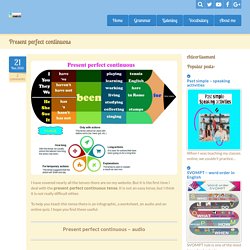
But it is the first time I deal with the present perfect continuous tense. It is not an easy tense, but I think it is not really difficult either. To help you teach this tense there is an infographic, a worksheet, a video and an online quiz. I hope you find these useful. Understanding The Present Perfect. Grammar Andy: Past Perfect. Grammar Andy: Present Perfect. Present perfect tense. To learn this difficult tense you first have to learn the past participles.
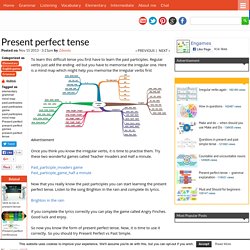
Regular verbs just add the ending -ed but you have to memorise the irregular one. Here is a mind map which might help you memorise the irregular verbs first Advertisement Once you think you know the irregular verbs, it is time to practise them. Try these two wonderful games called Teacher Invaders and Half a minute. Past_participle_invaders gamePast_participle_game_half a minute. Songs for practicing Present Perfect – part 1. Present perfect aspect – tips and activities. By Kerry G.Maxwell and Lindsay Clandfield Tips and ideas from Kerry Maxwell and Lindsay Clandfield on teaching the present perfect aspect.
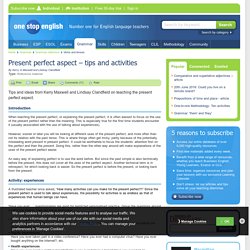
Introduction. Present Perfect Tense. Just, yet, still, already. Present Perfect or Past Perfect? Present Perfect Progressive Tense. English-Guide.org. English-Guide.org. Present Perfect Simple or Present Perfect Continuous The Easy Way. Present Perfect vs. Present Perfect Continuous. Present Perfect Progressive (Present Perfect Continuous) Present Perfect Continuous Tense. Present Perfect Continuous. Present Perfect and Simple Past Tense ESL Grammar Quiz. Present Perfect Exercises. Present perfect - experiences. English Grammar Games - Present Perfect. Interactive Present Perfect ESL Video Games for Young Learners. Present perfect. Present perfect continuous - a mind map - created and sent by Agnès Pihuit Imbert (Ac.
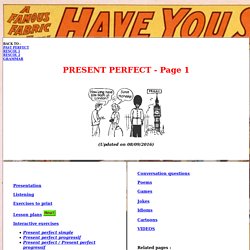
Nantes) Present perfect simple - a mind map - created and sent by Agnès Pihuit Imbert (Ac. Nantes) INTERACTIVE exercises : Present Perfect and Past Perfect in English + Exercises. Download two free English Grammar e-Books Both present perfect and past perfect talk about something that happened before a point in time (reference point).

The Past Perfect Simple Tense. Useful Tip Time Expressions in the Past Perfect Simple The time expressions already, for, since, and yet may be used in the past perfect simple, as they are in the present perfect simple.
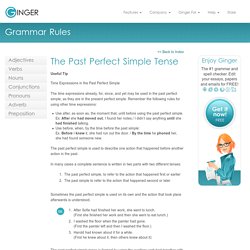
Remember the following rules for using other time expressions: Use after, as soon as, the moment that, until before using the past perfect simple. Ex: After she had moved out, I found her notes./ I didn’t say anything until she had finished talking.Use before, when, by the time before the past simple: Ex. The past perfect simple is used to describe one action that happened before another action in the past. In many cases a complete sentence is written in two parts with two different tenses: The past perfect simple, to refer to the action that happened first or earlierThe past simple to refer to the action that happened second or later Sometimes the past perfect simple is used on its own and the action that took place afterwards is understood.
After Sofie had finished her work, she went to lunch. Answers: Present Perfect. The present perfect is a verb tense which is used to show that an action has taken place once or many times before now.
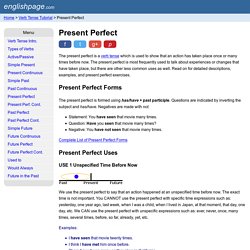
The present perfect is most frequently used to talk about experiences or changes that have taken place, but there are other less common uses as well. Read on for detailed descriptions, examples, and present perfect exercises. Present Perfect Forms The present perfect is formed using has/have + past participle. Questions are indicated by inverting the subject and has/have. Statement: You have seen that movie many times.Question: Have you seen that movie many times?